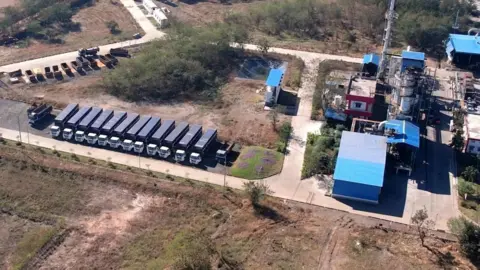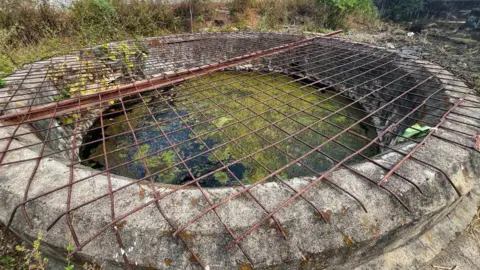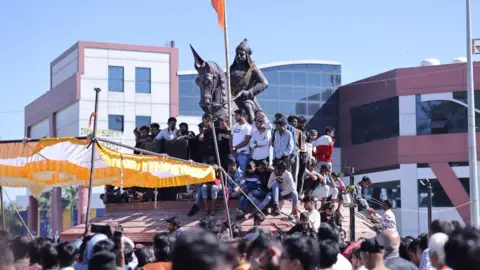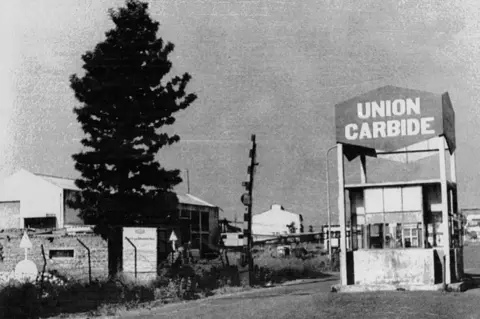Deadly toxic waste has fueled protests in India.
BBC Hindi
 BBC
BBCVegetable seller Shivnarayan Dasana has never seen so many policemen descend on the central Indian state of Madhya Pradesh.
A 60-year-old man lives Tarapur In the industrial city of Pithampur, known for its automobile and pharmaceutical factories. 337 tons of toxic waste from the site of one of the world’s worst industrial accidents is under tension in the city. It’s time to drop Three weeks ago.
The waste, from the now defunct Union Carbide plant in Bhopal City – The waste that was transported in 1984 due to the gas accident He was killed Thousands – has created a threat to local residents.
They worry that dumping it near their homes could be harmful and even an environmental hazard.
Protests erupted on January 3, a day after the garbage arrived in the city, leading to stone-pelting and self-immolation.
Since then, heavy police patrols near the waste facility have been shifted to Tarapur and surrounding areas to the virtual battlefield.
Although the police have registered seven cases against 100 people since the protests began, the city’s population continues to raise concerns about industrial pollution at small community meetings.

The toxic waste cleared from the Bhopal factory includes five types of hazardous materials – pesticide residues and “forever chemicals” left over from the manufacturing process. These chemicals are so named because they retain their toxic properties indefinitely.
Over the decades, these chemicals have seeped into the environment, posing a health risk to people living near the factory in Bhopal.
But the officials have dismissed the threat of garbage disposal causing environmental issues in Pithampur.
Senior official Swatantra Kumar Singh outlined the stalled process in an attempt to calm the crowd.
“Hazardous waste is incinerated at 1,200C (2,192F), in test batches of 90kg (194.4lb) and then 270kg are incinerated within three months if the toxicity level is reliable,” he said.
As Mr. Singh explained, “a four-layer filter cleans the smoke”, prevents toxins from entering the air, and the residues from combustion are “sealed in a double layer” and buried in a special landfill to protect the soil. Groundwater pollution.
Administrator Priyank Mishra said, “We have trained 100 ‘master trainers’ and are conducting sessions to explain the disposal process and build public confidence.”
Madhya Pradesh Chief Minister Mohan Yadav said that preventing garbage disposal is safe and necessary. He urged the residents to express their grievances legally.
Environmentalists, however, have a different view on the process.
Some people like Subhash C Pandey believe that disposal poses no risk if done properly. Others, like Shimala Mani, are looking for alternatives to burnout. She argues that incineration increases the residual soot and releases harmful toxins such as mercury and dioxins.
Ms. Mani pointed out that bioremediation, the process of breaking down harmful substances in waste using microorganisms, could be a more effective and environmentally friendly solution.
But residents are still skeptical.

“It’s not just waste, it’s poison,” said Gayatri Tiwari, a mother of five in Tarapur village. “What’s the point of life if we can’t breathe clean air or drink clean water?”
Pollution is an undeniable reality for residents of Pithampur. Residents cite past groundwater contamination and ongoing health problems as concerns.
In the year The city’s rapid industrial growth in the 1980s led to hazardous waste deposits, contaminated water and soil with mercury, arsenic and sulfates. In the year In 2017, the central pollution control office of the federal agency indicated high pollution in the area.
Local residents say that many companies do not follow the rules to dispose of non-hazardous waste, preferring to dump it in the soil or water. In the year Tests in 2024 showed elevated levels of harmful substances in the water. Activists link this to environmental violations at the waste facility, but officials deny this.
“Water filters in our homes don’t last for two months. Skin diseases and kidney stones are common now. Pollution has made life unbearable,” said 32-year-old Pankaj Patel, pointing to the water filter that needs frequent replacement.
Srinivas Dwivedi, regional officer of the state pollution control board, dismissed concerns that maintaining pre-industrial conditions in Pithampur was “unrealistic”.
 Getty Images
Getty ImagesMeanwhile, in Bhopal, 230 km (143 miles) from Pithampur, activists argue that the removal process is a distraction from larger issues.
After the accident, the toxic substance sat in the mothballed factory for decades, contaminating the groundwater in the area.
According to a 2010 report by the National Environmental Engineering Research Institute and the National Geophysical Research Institute, more than 1.1 million tons of contaminated soil remains at the Union Carbide plant site.
“The government is making a show of removing 337 metric tonnes while ignoring the huge problem in Bhopal,” said chief environmentalist Nityanand Jayaraman.
Another activist, Rachana Dhingra, added, “Pollution has worsened over the years, but the government has done little to address the problem.
The government estimates that 3,500 people died soon after the gas leak, and more than 15,000 others died. Activists say the toll is far too high, with victims still suffering from the side effects of the poisoning.
“Given Pithampur’s history of pollution, residents’ fears are justified,” Mr. Jayaraman said.
The officials said, “They are handling the waste as per the instructions of the court.”
But the reality of Bhopal has increased the distrust among the people of Pithampur, who are now ready to take to the streets again to protest against the dumping.
Vegetable seller Shivnarayan Dasana says the issue is more than garbage.
“It’s our survival and our children’s survival,” he said.
Follow BBC News India Instagram, YouTube, Twitter And Facebook.


